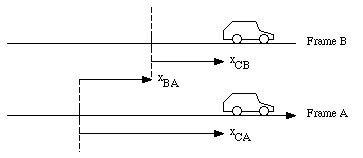Acceleration in Plane Motion:
If a body is performing plane motion and acceleration of the pole A and angular acceleration of the body is known, then we may calculate the acceleration of any other point B as illustrated in Figure.

We have
rB = rA + rAB
∴ d 2 rB /dt 2 = d 2 rA /dt 2 + d 2 rAB /dt 2
or a B = a A + a AB
where,
a A = Acceleration of pole A, and
a AB = Acceleration of B with respect to A.
Figure 5.38
But, we know that B rotates about A, with ω and α as angular velocity and acceleration respectively.
∴ a AB = a AB t^ + a AB n^
= AB . α + AB . ω2
Perpendicular AB From B → A
∴ d 2 rB/ dt 2 = d 2 rA/ dt 2 + d/dt. (ω × rAB )
= d 2 rA/ dt 2 = (d ω¯/ dt) rAB + ω¯ (d rAB /dt)
∴ aB = a A + α × rAB + ω rAB
= a A + a AB t^ + a AB n^
These components are shown in Figure and by combining these vectors we may get the final acceleration of point B.